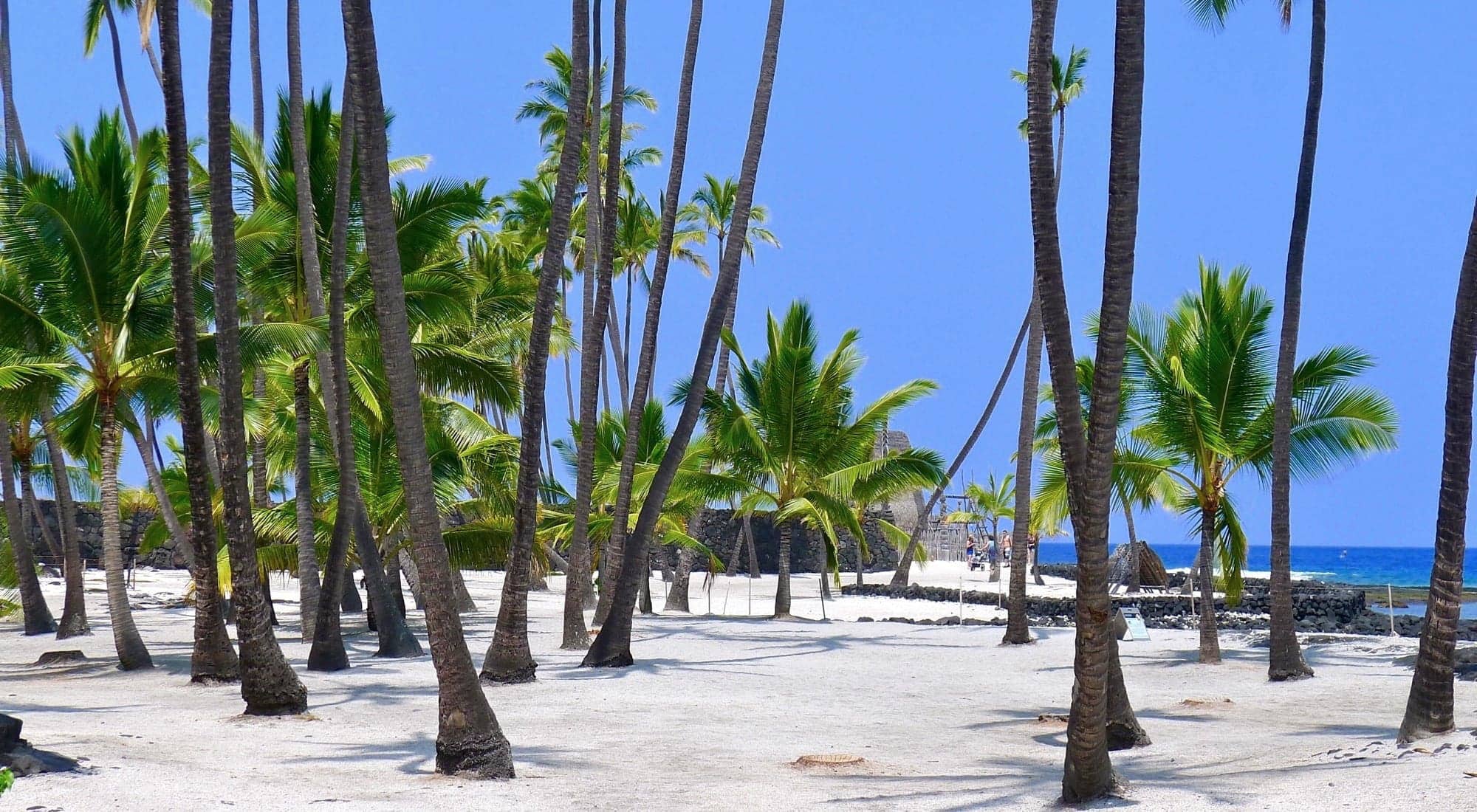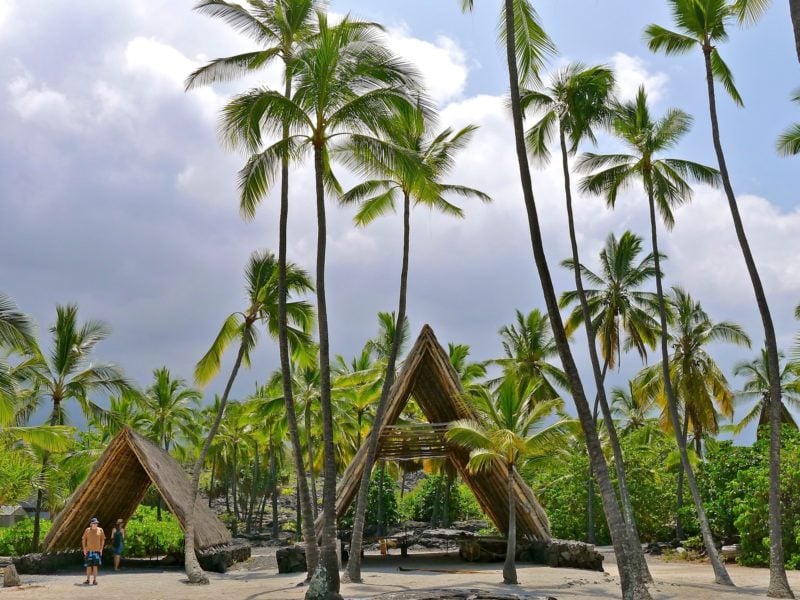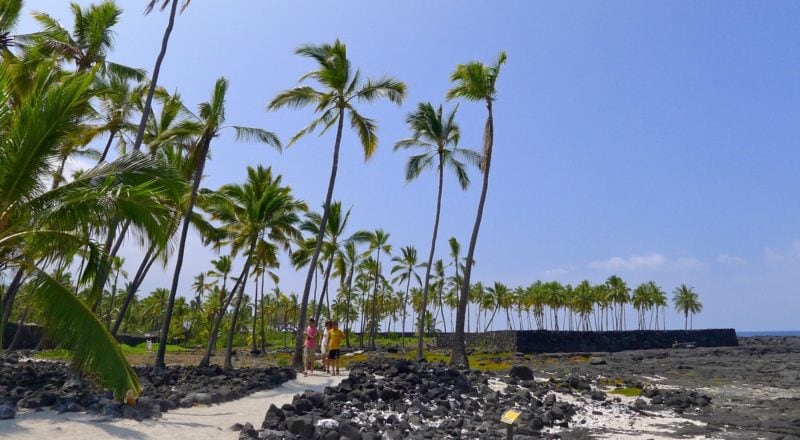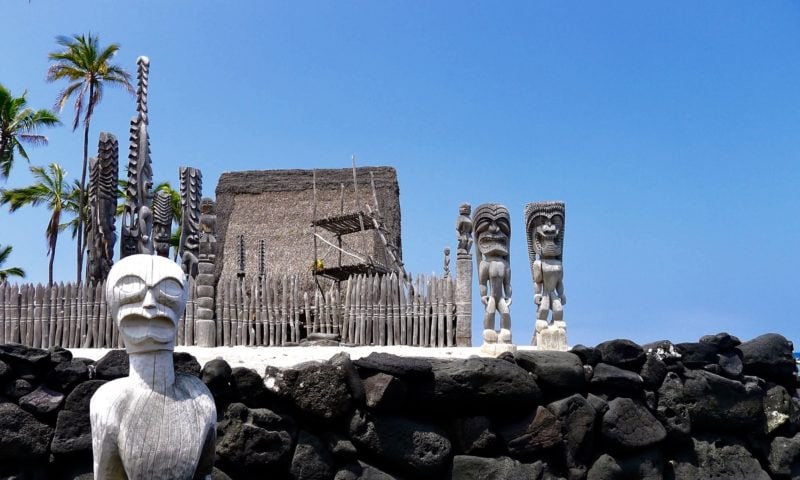Step back in time and into a piece of living Hawaiian history – Puʻuhonua o Hōnaunau National Historical Park. A tour of this park is one of the top things to do on the west (Kona) side of the Big Island and an excellent way to experience traditional Hawaiian culture.
Use the Table of Contents to skip ahead to the information you are looking for:
Table of contents
- About Puuhonua o Honaunau
- Things to see in the park
- History + cultural significance
- The Kapu system
- Kiʻi
- Practical information
- Things to do close to the park (activities and places to eat)
Table of Contents
- About Puuhonua o Honaunau
- Things to see in the park
- History + cultural significance
- The Kapu system
- Kiʻi
- Practical information
- Things to do close to the park (activities and places to eat)
Visitors to this special place will notice the peaceful energy and spirit of forgiveness that can be felt throughout the park to this day. For this and many other reasons, visiting the Puʻuhonua o Hōnaunau National Historical Park is one of our favorite things to do.
Read more in our BIG list of cultural and historical things to do on the Big Island.
About the Puʻuhonua o Hōnaunau National Historical Park
Set on the rugged and beautiful south Kona coast, the ‘place of refuge’ or ‘city of refuge’ was a safe haven for those that broke the Kapu laws, which in old Hawaii were punishable by death. If you reached the Puʻuhonua, you would be pardoned by Kahuna and given a second chance at life. A sacred site, carrying the powerful mana of 23 interred Aliʻi chiefs, the Puʻuhonua and Royal Grounds were used by the Hawaiians for centuries.
If you feel adventurous and want to have a quick look at the park this virtual tour of the park by the NPS is worth your time.
Things to do/see in the park + visitor tips
Visitors can walk through the park on a self-guided tour on a 0.5 mile trail. Be sure to grab a park map that corresponds to numbered markers along the trail so you can read about different points of interest (or have a look at page 4 and 5 of the online version here). You can also access a narrated tour by phone that follows the numbered stops on the map by calling (808) 217 9279.
Park Ranger talks on the history of Hawaiʻi and the park are offered daily in the Amphitheater next to the Visitor’s Center. Times for these talks are posted outside the Visitor’s Center, which is open 8:30 am – 4:30 pm.
You can easily spend a few hours in the park exploring the views and sights but if you are short on time you can consider only seeing the Royal grounds and Puʻuhonua (see map below). We describe the most important sections / attractions of the park to give you a good idea of what you’ll see / learn while visiting:
- Visitor Center
- Royal Grounds
- Puʻuhonua (place of refuge)
- 1871 Trail & Kiʻilae Village

Annotated map of the Puʻuhonua o Hōnaunau National Historical Park showing park attractions such as the visitor center, the great wall, the royal grounds, and the Puʻuhonua. Satellite image adapted from Google Maps.
Visitor’s Center
The Visitor’s Center and bookstore is your point of arrival once you enter the park. This is where you can pick up a map for a self-guided tour, and a staff member can answer any questions you have. The bookstore has a collection of excellent reads and some DVDs on Hawaiian culture, history, geology, and legends. The bathrooms are located directly to the left of the bookstore. The Amphitheater where ranger talks are held is to the right.
The Royal Grounds
As you enter the Royal Grounds, you walk beneath towering coconut palms. These trees are part of a royal coconut grove, planted to commemorate chiefs who have passed on.
The Hale o Keawe Temple, guarded by carved wooden Kiʻi, symbolizing Hawaiian gods, is a very sacred site. It was build in the 1600s to house the bones of Keawe-‘Ī-kekahi-ali ‘i-o-ka-moku, King of Hawai‘i Island. After Keawe’s death 22 others were cremated and deposited in the temple along with numerous unnamed warriors. The sacred bones were full mana (spiritual power) that emanated out and surrounded the refuge. Today, the remains of the chiefs rest inside the mausoleum at Mauna Ala on the Island of O‘ahu and Hale o Keawe was reconstructed 50 years ago to help bring Hawaiian history to life. (read more about Hale o Keawe).
The Temple and the Royal Grounds are protected and separated from the Puʻuhonua by a Great Wall, constructed over 500 years ago in the 1500s using uhua humu pohaku, or dry stack masonry with lava rock. Over 80% of the original wall was still intact when this site was reconstructed and restored in the late 1960s. The wall measures up to 12 feet tall, 18 feet wide, and 950 feet long.
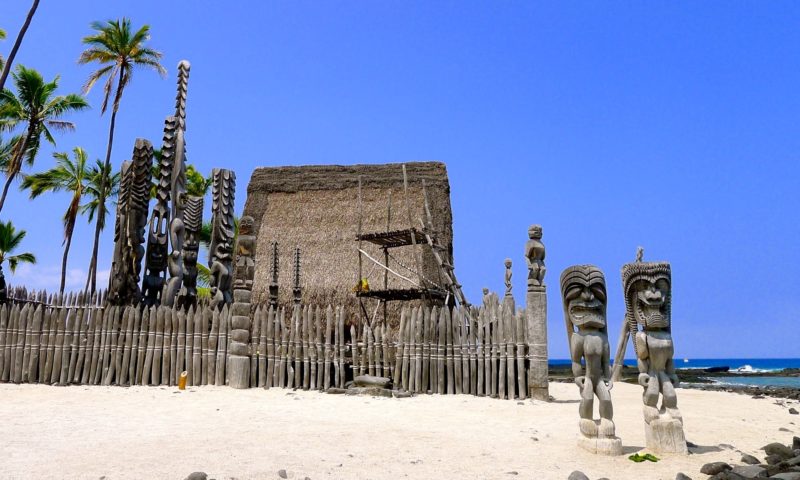
Hale o Keawe served in ancient times as a royal mausoleum, housing the remains of deified high chiefs.
There are many other points of interest inside the Royal Grounds, including Keone‘ele Cove, a canoe landing for Aliʻi, a Hālau waʻa (canoe house), fish ponds, and Kōnane, a Hawaiian strategy game played with rocks that resembles checkers.
The Royal Grounds end at the “Great Wall”, beyond which you can find Puʻuhonua.
The Puʻuhonua (place of refuge)
Imagine swimming for your life in the open ocean, dodging sharks, currents, and pursuers as a wanted man or woman. You have broken a law in the Kapu System, which is punishable by death. You are headed to the Puʻuhonua, or ‘place of refuge’, where you can take sanctuary and receive a pardon from a Kahuna (high priest). This was the reality of old Hawaii, where a ruling class of Aliʻi (chiefs) managed the island of Hawaii through strict enforcement of Kapu.
The island was divided into six districts, or Moku, each with their own Puʻuhonua. Rather than penal punishment or jail, the old Hawaiian way of dealing with criminals was spiritual.
When you visit the Puʻuhonua, you can walk in the footsteps of those that sought refuge here over the course of centuries, and see where the Aliʻi and Kahuna who pardoned them resided. The Puʻuhonua was not only for those that had broken a law, but a safe place for women, children, and elderly during times of war. As you walk through the Puʻuhonua you will see the foundations of older heiaus (temples), and the Great Wall that separates the Puʻuhonua from the Royal Grounds.
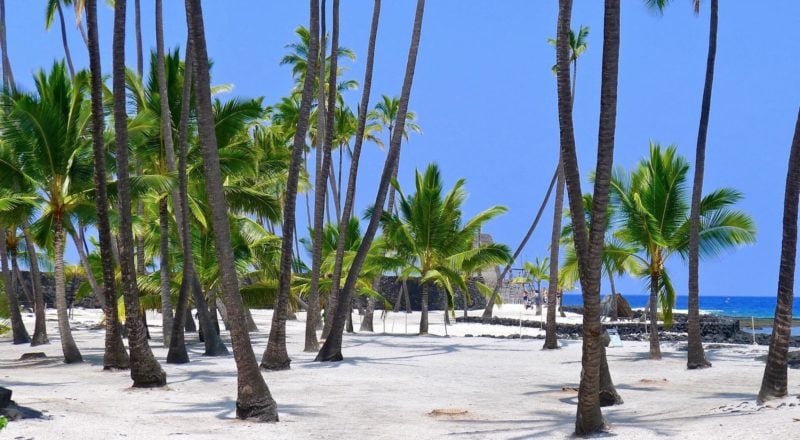
Looking from the Royal grounds through a coconut grove to the Great Wall that shields the Puʻuhonua (place of refuge) part of the park.
1871 Trail & Kiʻilae Village
Long before roads, Hawaiians used a sophisticated network of foot trails to move from one place to another on the island. The 1871 trail offers visitors a chance to walk back in time on a real trail that leads to the site of an abandoned fishing village. The trail begins behind the Visitor’s Center and passes by Alahaka Heiau and other remnants of old Hawaiian settlement.
The hike to Kiʻilae Village is 2.5 miles round trip and the trail is extremely peaceful and quiet, with sweeping views of the mountains to the left. Medicinal Noni trees grow along the trail, making a natural perch for many birds. A second coastal trail intersects the 1871 trail and can be taken as an alternate route on the way back, where it passes the site of what was once the Keawe House and ‘Oʻmaʻ Heiau.
Annual Cultural Festival & Craft Demonstrations
Every summer at the end of June, Hawaiian cultural practitioners gather at Pu‘uhonua o Hōnaunau National Historical Park for festivities and traditional craft demonstrations. Lei making, lauhala weaving, wood carving, and other Hawaiian crafts are practiced by skilled artisans. For more information, contact the Visitor’s Center or see the park event page.
History & Cultural Significance
It is pretty mind-blowing to think that just over 200 years ago, the Puʻuhonua was still in use as a place of refuge and the Kapu system was the law of the land across Hawaii! Read about the park history and cultural significance below to find out more about the Kapu system and the park history and cultural significance:
History of the Puʻuhonua o Hōnaunau National Historical Park
The Puʻuhonua, Royal Grounds, and surrounding historical sites were designated as a National Park in 1961. The wall around the Royal Grounds dates to the 1500s, and the original Hale o Keawe Temple was built in the 1600s. Other remains of heiaus (temples) on the site are believed to date back earlier.
This sacred site was used by Hawaiians for several centuries until the end of the Kapu system in 1819. The rise of Christianity and suppression of the Hawaiian religion meant that the temples were destroyed or allowed to fall into disrepair. In 1961, the area was designated as a National Historical Park. In the late 1960s, the site structures were rebuilt in replica using traditional materials and processes. The Great Wall, which was still 80% intact after 500 years was restored, along with other heiau foundations on the grounds.
The Kapu System
In old Hawaii, the Kapu system, a code of strict laws formed the foundation of Hawaiian society and culture. The Aliʻi, or ruling class of chiefs who migrated to Hawaii from Tahiti were believed to have a divine power or ‘mana’ that gave them the right to govern society.
Many of the Kapu laws were designed to control access to certain places and regulate sustainable use of natural resources, as well as maintain social classes. Commoners could not look an Ali’i in the eye, or cast their shadow upon them. Men and women could not eat together, and women could not eat certain foods that symbolized gods like bananas, coconuts, or pig. Fishing during spawning was forbidden.
The punishment for breaking a law was death. The concept of jail, or detaining criminals was not practiced. The only way to avoid punishment was to reach the nearest Puʻuhonua. Within the walls, you were safe. After spending a short time in the Puʻuhonua, you would be pardoned by Kahuna (priest) and allowed to return home.
Kiʻi
Surrounding the Hale o Keawe Temple you will notice many Kiʻi, or carved wooden statues of Hawaiian gods. In the Hawaiian language, Kiʻi means ‘images’, and they are a key part of Hawaiian spirituality. Kiʻi are fashioned out of wood or stone and serve as the embodiment of a deity, either akua (gods) or ʻaumākua (personal or family guardians).
Practicalities (directions, admission)
The park is open 7 am to sunset daily and located in Hōnaunau, about 20 miles south and approximately 40 minutes drive from downtown Kailua-Kona. To get there use your GPS or the following route descriptions.
- Directions + parking
- Admission
- Good to know: Visitor tips!
Directions:
From Kona, head south on Highway 11 for about 20 miles. Turn right at Highway 160 which will take you down toward the coast. The entrance to the park will be in your left, with a large sign and Kiʻi. Travel time to the park from Kailua-Kona is about 40 minutes.
From Hilo, you can head to the park over Saddle Road, and then follow directions from Kona. This route is about 100 miles, with a travel time of approximately 2 hours, 11 minutes from downtown Hilo. An alternate route is to drive around the southern tip of the island, through Volcano National Park, Kaʻu, and Ocean View to Hōnaunau, where you’ll make a left onto Highway 160. This route is only slightly longer, at about 109 miles and approximately 2 hours, 25 minutes of travel time.
Parking:
Parking is available just inside the park gates. Parking is included in your entrance fee of $20 per vehicle.
Park admission / entrance fees
The entrance fees for the park are as follows (last updated July 2023):
- $20.00 per private non-commercial vehicle (capacity 15 or less) – 7 days
- $10.00 per pedestrian or bicycle – 7 days
- $15.00 per motorcycle – 7 days
- $35.00 Puʻuhonua o Hōnaunau NHP Annual Pass
- $55.00 Hawai‘i Tri-park Annual Pass
Good to know: The Puʻuhonua O Hōnaunau National Historical Park will only accept credit or debit cards for entrance fees and passes.
If you are planning to visit other National Parks such as the Hawaii Volcanoes National Park we recommend that you buy the Hawai‘i Tri-Park Pass ($55.00 in 2023). This pass allows access for 1 full year from date of first use at Hawai‘i Volcanoes National Park, Pu‘uhonua o Hōnaunau National Historical Park, and Haleakalā National Park (on Maui).
Helpful Tips for Visitors
When visiting keep the following things in mind:
- Plan to be outdoors, with little shade
- Wear comfortable walking shoes
- Allow at least 1 – 1.5 hours to see the Puʻuhonua, Royal Grounds, and Visitor’s Center
- Allow more time if you plan to hike the 1871 trail
- Don’t swim or sunbathe on the park grounds
- Don’t touch, move, or climb on artifacts and sacred sites
Things to do close to Puʻuhonua o Hōnaunau:
There are many things to do close to the park which makes for some great road trips. We give some tips below about other things to do and nearby restaurants.
Activities:
- Snorkeling: Right next to Puʻuhonua o Hōnaunau is Hōnaunau Bay, one of our favorite snorkeling spots here on the Big Island! The bay teems with tropical fish and sea turtles. Large brain coral formations and sea arches make up the underwater landscape. Note that you’ll need to bring your own snorkel gear.
- Road trip! A visit to the park fits perfectly into a day-long road trip that also includes a visit to a Kona coffee farm and lots of snorkeling. See our South Kona scenic drive description for details.
- Coffee? The south Kona district is world famous for its Kona coffee. See our Kona Coffee Guide for a list of our favorite coffee farm tours.
Where to eat nearby
There are plenty of good places to stop for a bite along the way back to Kona.
- For an authentic Hawaiian plate lunch, head to Super J’s (or see their facebook page), in Honaunau, famous for their laulaus.
- Just south of Captain Cook, The Coffee Shack offers standard American breakfast and lunch fare, with stunning bird’s eye views of the coast thousands of feet below. They also serve good pie and coffee.
- Further north, Kainaliu town has several different places to choose from, including Annie’s Burgers, Cultivate Good Food for vegan fare, and Kaya’s Cafe, a local coffee shop with excellent homemade quiche and vegan/gluten-free baked goods.
- Historic Teshima’s restaurant serves up a mix of local, Japanese, and American food in a sit-down environment.
